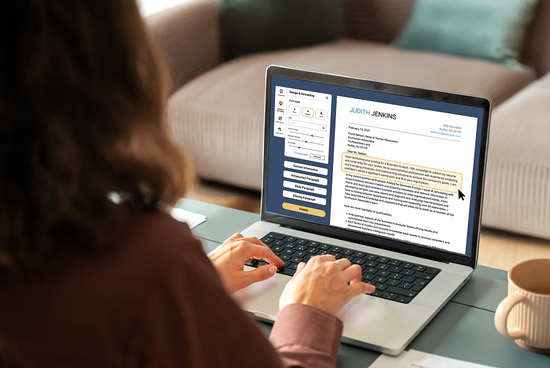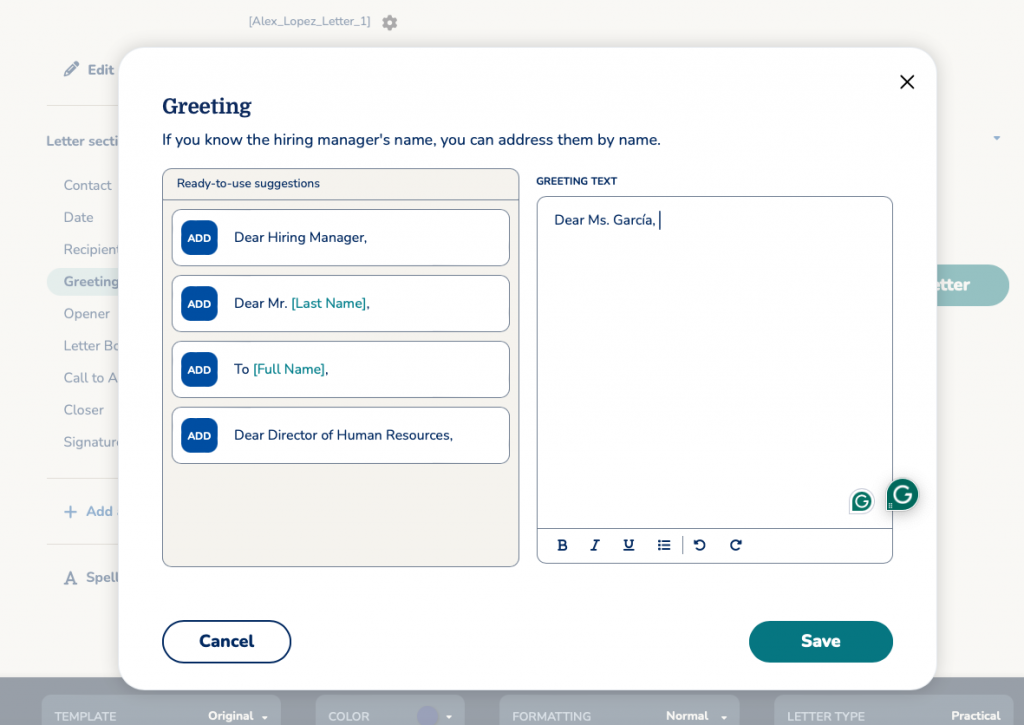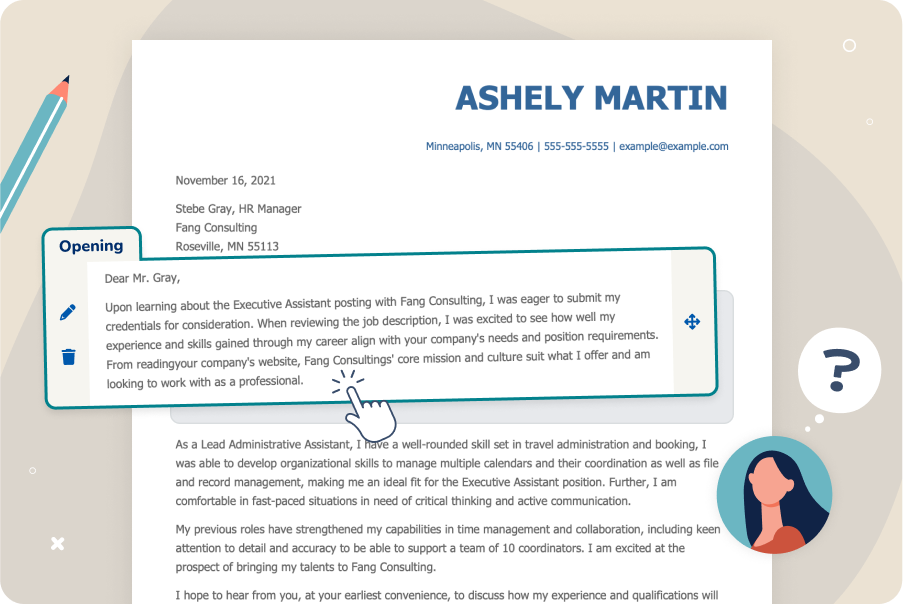Our customers have been hired at: *Foot Note
Every element of your cover letter — including the greeting — offers an opportunity to set yourself apart and highlight why you’re the perfect fit for the role.
In this guide, we’ll explore how to craft a cover letter greeting that conveys your professionalism, attention to detail, and genuine connection to the company to which you’re applying.
Browse crafted examples and get tips on navigating common hurdles, including how to address a cover letter when you don’t know the hiring manager’s name. Let’s get started!
Who Should You Address a Cover Letter To?
The first step in writing a cover letter is researching the company with the goal of addressing your letter to the person most likely to review your application.
Ideally, you should address it to a specific individual — such as the hiring manager, recruiter, or department head — whose name you can often find in the job posting, on the company’s website, or via professional networks like LinkedIn.
With our Cover Letter Generator, you can customize your cover letter greeting or choose from one of our prewritten suggestions:
How to Address a Cover Letter With a Name
Tailoring your salutation to a specific person demonstrates your attention to detail and signals your genuine interest in the role. Explore the tips below to get started.
Use a professional title
Start with a formal salutation, such as “Dear,” followed by the recipient’s appropriate title (“Ms.” or “Mr.”) and last name. Here are some examples:
- Dear Mr. Jones
- Dear Ms. García
- Dear Mr. Lopez
- Dear Ms. Davis
Keep it neutral
Avoid using "Miss" or "Mrs." in your cover letter. These titles unnecessarily assume marital status and can come off as outdated or overly familiar.
Instead, opt for "Ms." or confirm the recipient's preferred title to ensure your greeting is both respectful and aligned with modern professional standards.
If you're unsure about the recipient’s gender or preferred title, consider addressing them by their full name instead. For example:
- Dear Sydney García
- Dear Alex Lopez
Make sure you have the correct spelling of the name and title. To verify this information, double-check the company's website, job posting, or professional networking profiles.
Include professional titles
When your contact holds an academic or professional title, it’s important to acknowledge and use that designation to show respect and attention to detail.
For example, if Sydney García has a Ph.D, address her as "Dr. García" instead of "Ms. García."
Here are a few more examples of how to address a cover letter when the recipient has an academic or professional title:
- Dear Dr. Smith
- Dear Professor Johnson
- Dear Dean Williams
- Dear Attorney Brown
- Dear Judge Roberts
We recommend using one of our cover letter templates to ensure your cover letter salutation is formatted correctly.
How to Find the Recipient’s Name
Taking the time to research the recipient's full name conveys your professionalism and attention to detail. Here are a few ways you can find out their name:
- Review the job posting: Often, the advertisement or job listing includes the name of the hiring manager or contact person. Look for phrases like “Contact:” or “Hiring Manager.”
- Check the company website: Look at the “About Us,” “Team,” or “Careers” pages. These pages often list key personnel and provide details about the relevant department.
- Search on LinkedIn: If not on their website, the company's LinkedIn can offer insight into the people working there. Start searching in the department you're applying to.
- Make some calls: If the name isn’t readily available online, consider calling the company’s front desk or HR department.
- Network: Contact your professional contacts or alumni network to see if anyone can provide the name of the person responsible for hiring at the company.
How to Address a Cover Letter Without a Name
If your research doesn’t yield a specific name, there are a few alternatives for ensuring that your letter maintains a respectful and professional tone.
Use a general greeting
You can use a respectful, general greeting to show that you’ve made an effort, even if you couldn’t pinpoint the exact individual. Here are a few examples:
- Dear Hiring Manager
- Dear Recruiting Team
- Dear Hiring Committee
Address the team
You can further personalize your cover letter greeting by including the company name, the team or department you are applying for, or the role of the recipient who is likely to read your letter.
Here are a few examples:
- Dear Acme Corporation Team
- Dear Marketing Department Hiring Team
- Dear Director of Marketing
- Dear TechNova Solutions Recruiting Staff
Check out our cover letter format guide to ensure your cover letter is polished and professional.
Why Your Cover Letter Salutation Matters
Your cover letter salutation is more than just a formality — it's the opening handshake with your prospective employer.
A thoughtful, personalized greeting after your cover letter header demonstrates that you've taken the time to research the company and understand who you're addressing.
This level of detail not only conveys professionalism but also signals that you value the opportunity and are serious about making a strong first impression.
In a competitive job market, a well-crafted greeting can set the tone for the entire letter and make you stand out as a considerate and detail-oriented candidate.
Examples of Proper Cover Letter Greetings
Explore the cover letter examples below to see the various ways you can address the recipient of your cover letter.
Teacher
This teacher cover letter example formally addresses the recipient using their full name, which demonstrates attention to detail and establishes a respectful, professional tone.
Administrative Assistant
This administrative assistant cover letter example uses the formal “Ms.” when addressing the store manager, another excellent option for your own cover letter.
Data Entry Specialist
In this data entry specialist cover letter example, the job seeker addresses the human resources manager using “Mr.” to establish a courteous and formal tone.
Common Mistakes to Avoid
- Using generic greetings: Avoid default salutations like "To Whom It May Concern" or "Dear Sir/Madam." They can come across as impersonal and signal a lack of effort.
- Incorrect or misspelled names: A simple typo or misspelling can make a negative impression. Double-check the spelling of the recipient's name.
- Outdated titles or information: Relying on old contact details or titles can undermine your credibility. Always verify that the recipient’s information is current and accurate.
- Overly informal language: While the tone should be approachable, using casual language or greetings like “Hi” can appear unprofessional.
- Making gender assumptions: If you’re unsure of the recipient's gender, opt for gender-neutral language or do further research.
- Improper formatting: Ensure your greeting aligns with the overall format of your cover letter. A poorly formatted salutation can detract from an otherwise polished application.
- Addressing it to the wrong person: If you use the same cover letter for multiple job postings, ensure the recipient's name is correct.
How to Address an Email Cover Letter
If you're not applying through a job portal, you'll need to email your cover letter and resume directly as part of your application.
We suggest attaching it as a document, but the employer may require you to format it in the body of the email.
In either scenario, the most critical aspect is to write a concise subject line the recruiter can quickly identify.
It should include the position you're applying for and your name. Here are a few examples of effective subject lines when emailing your cover letter:
- Lily Ramírez – Marketing Intern Job Application
- Mark Silva – Store Manager Job Application, referred by Emily Biles
- Customer Service Specialist Position – Sarah Lee
If you're writing your cover letter inside the email, leave out the address and date. Start with your salutation, and ensure you include your contact information and email signature.
We recommend exploring our guide on preparing your resume for email for additional tips and examples to help you make a strong first impression.
Key Takeaways
- Correctly addressing your cover letter is as important as the document's body. It's the first thing the hiring manager will see, showing that you did your research.
- Always use the formal "Dear Mr. or Ms." followed by their last name. If the recipient has a professional or academic title, it's more appropriate to address them by that title.
- Do not use outdated greetings like "To whom it may concern," and avoid overly casual salutations such as "Hey" or "What's up."
- If you don't know the recipient's gender, opt to use "Dear [Full Name]" to maintain a respectful and professional tone.
- The hiring manager's name can typically be found in the job listing, on the company's website, on LinkedIn, or by asking a friend who works at the company.
- If you cannot find a name, address the cover letter to the hiring staff, the department you're applying to, or the company.
- When emailing your cover letter, always include your name and the position you're applying to in the subject line.
FAQ
How do you address a cover letter to an unknown recipient?
One way to address a cover letter when you don’t know the person’s name is to use “Dear Hiring Manager,” however, it’s best to get more specific if you can.
Another option is to address the cover letter to the department you’re applying to or the hiring staff. Here are examples of how to address a cover letter with no name:
- Dear Marketing Department
- Dear [Company Name] Hiring Team
See our guide on what to include in a cover letter for additional tips and examples to help you craft a cover letter that stands out.
What is the proper greeting for a cover letter?
The proper greeting for a cover letter is both personalized and formal. Ideally, you should address it directly to the specific individual responsible for hiring.
For example, “Dear Mr. Smith,” “Dear Ms. Johnson,” or “Dear Dr. Brown.” If you can’t find a name, opt for a respectful general greeting such as “Dear Recruiting Team.”
Avoid overly casual greetings like “Hi” or “Hello” without a title, as these can undermine the professional tone of your application.
Explore cover letter tips to learn about additional best practices to help you create a polished and professional cover letter.
Is it OK to address a cover letter with to whom it may concern?
Addressing your cover letter with “To Whom It May Concern” is generally considered outdated and impersonal. Likewise, avoid using “Dear Sir/Madam.”
It’s better to invest a little extra time finding the specific hiring manager’s name or use a more tailored greeting such as “Dear Hiring Manager” or “Dear [Company Name] Team.”
See our simple cover letter examples for additional inspiration when crafting your letter. This approach demonstrates effort and can make a stronger, more personal first impression.
Review how to start a cover letter for expert strategies to ensure your cover letter stands out to hiring managers.
How We Reviewed This Article
Since 2012, we have helped more than 11 million job seekers. We want to make your career journey accessible and manageable through our services and Career Center’s how-to guides and tips. In our commitment to bring you a transparent process, we present our Editorial Process.
Our customers have been hired at:*Foot Note









